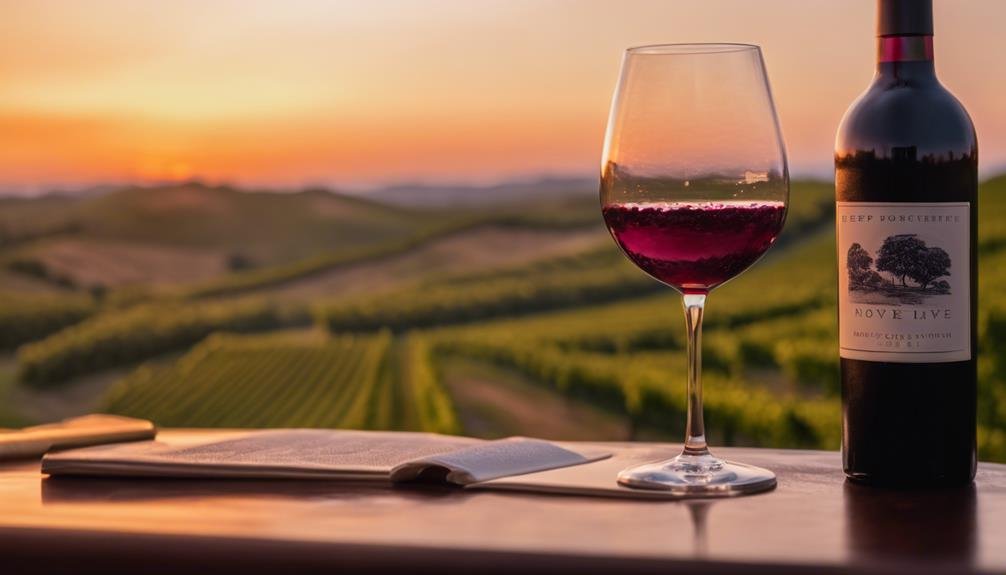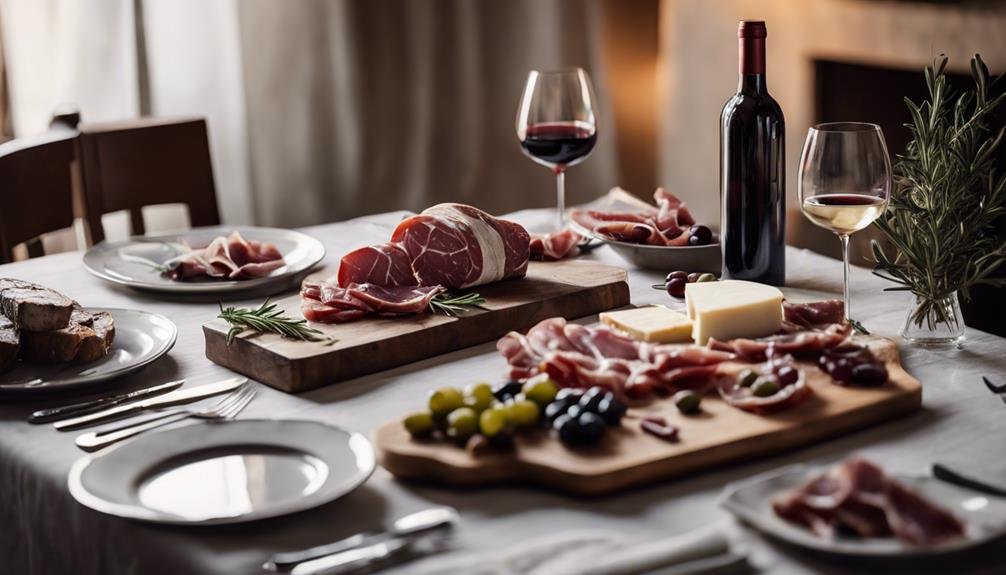Uncover the richness of Mourvedre wines, originating from the Mediterranean and known as Monastrell in Spain. These late ripening grapes boast high tannins and a complex flavor profile. Diverse terroirs influence their taste, with Spain offering bold flavors, France an elegant touch, and Australia and the US unique characteristics. Expect intricate aromas of dark fruits and floral notes in these full-bodied wines, best enjoyed at 67-71 °F. Examples like Tarima Hill and Domaine Tempier showcase aging potential and pair excellently with rich meats, elevating the experience. Discover a world of flavors, aging potentials, and terroirs that make Mourvedre wines truly special.
Mourvedre Grape: Origins and Characteristics
Originating from the Mediterranean region, the Mourvedre grape, also known as Monastrell in Spain, is characterized by its late ripening, high tannins, and complex flavor profile.
This grape's origins can be traced back to Spain, where it thrives in regions like Alicante, Jumilla, and Almansa, showcasing unique styles influenced by local terroirs. Mourvedre vines exhibit remarkable diversity in vineyards worldwide, adapting to different climates and soil compositions.
When it comes to food pairings, Mourvedre wines complement rich dishes such as beef short ribs, pork shoulder, and lamb, enhancing the dining experience with their bold flavors. Winemakers often employ techniques like medium to long oak aging to enhance the wine's structure and aging potential, creating wines that evolve beautifully over time.
Diverse Terroirs for Mourvedre Wines
With distinct regional influences, Mourvedre wines showcase a wide array of terroirs that contribute to their unique characteristics and flavor profiles. Exploring terroir nuances reveals how climate influences the development of Mourvedre grapes, leading to diverse expressions in different regions.
In Spain, areas like Alicante, Jumilla, and Almansa offer warm climates that enhance the grape's rich and bold flavors. In France, particularly in Bandol and the Rhône region, the terroir imparts a more elegant and structured profile to the wines.
Australia's South Australia region and the United States' California and Washington areas also provide unique terroirs that influence the final taste of Mourvedre wines. These diverse terroirs offer exciting culinary adventures, with food pairings ranging from rich meats like beef and lamb to vegetarian dishes enhanced with regional spices.
Tasting Notes and Flavor Profiles

Exploring the intricate flavors and aromatic profiles of Mourvedre wines reveals a sensory journey enriched by the grape's diverse terroirs and winemaking techniques.
Mourvedre offers a unique sensory experience with its complexity. These wines often exhibit a meaty and full-bodied character, accompanied by aromas of dark fruits like blueberry and blackberry, floral notes such as violet, and hints of black pepper.
In regions like Bandol, France, and Jumilla, Spain, a gamey taste adds to the wine's allure. With medium to long oak aging, Mourvedre wines typically have high tannins and medium(+) acidity, creating a balanced structure.
Decanting can enhance the flavors, and serving them at 67-71 °F brings out the best in this intriguing varietal.
Notable Examples of Mourvedre Wines
Highlighting the distinct characteristics and exceptional quality of select Mourvedre wines elevates the appreciation for this varietal among wine enthusiasts and connoisseurs alike. When exploring notable examples of Mourvedre wines, two stand out for their exceptional quality and unique profiles:
| Wine | Origin | Aging Potential |
|---|---|---|
| Tarima Hill | Spain | 5-10 years |
| Domaine Tempier | France | 10-20 years |
Tarima Hill, a Spanish Monastrell wine, offers a full-bodied experience with blackberry and blueberry notes, showcasing an aging potential of 5-10 years. On the other hand, Domaine Tempier from France presents rich, meaty aromas with chocolate and mocha overtones, and can age gracefully for 10-20 years. Both these wines pair excellently with rich meats like beef short ribs and have significant aging potential.
Pairing Suggestions and Culinary Matches

Considering the robust and complex nature of Mourvedre wines, thoughtful pairing suggestions and culinary matches can enhance the overall dining experience.
- Exploring Umami pairings: Embrace the savory richness of Mourvedre wines by pairing them with dishes rich in umami flavors such as braised mushrooms, miso-glazed eggplant, or soy-marinated tofu.
- Wine and spice combinations: Enhance the aromatic profile of Mourvedre wines by pairing them with dishes seasoned with spices like black pepper, cumin, smoked paprika, or cloves to create a harmonious balance of flavors.
- Rich meat dishes: Opt for hearty meat options like braised beef short ribs, grilled lamb chops, or slow-cooked pork shoulder to complement the bold tannins and full-bodied texture of Mourvedre wines.
- Vegetarian delights: For a vegetarian pairing, consider dishes like lentil stew, wild mushroom risotto, or roasted vegetable medley seasoned with herbs like rosemary and thyme to create a satisfying culinary match.
Frequently Asked Questions
Can Mourvedre Wines Be Aged for Extended Periods?
Mourvedre wines can be aged for extended periods, showcasing improved complexity, softened tannins, and enhanced flavor profiles. With aging potential varying by region and winemaking styles, these wines often develop meaty, spicy, and earthy characteristics over time.
How Does the Mourvedre Grape Contribute to Sparkling Wines?
The Mourvedre grape brings depth and complexity to sparkling wines with its distinctive taste profiles of dark fruit, floral notes, and earthy undertones. Its late ripening nature adds richness to blends, enhancing the winemaking process.
Are There Any Unique Winemaking Techniques Specific to Mourvedre?
Traditional winemaking methods for Mourvedre include extended maceration for tannin extraction, fermentation techniques like native yeast for complexity, and barrel aging for oak integration. Vineyard practices focus on low yields, enhancing grape concentration. Soil composition and climate influence flavor development.
What Makes Mourvedre Ideal for Blending in Certain Regions?
Mourvedre's suitability for blending in certain regions stems from its robust flavor profiles, high tannins, and medium acidity, allowing it to harmonize with other varietals. Winemakers leverage its rich, meaty characteristics to enhance blends, especially in warmer climates.
How Does the ABV of Mourvedre Wines Compare to Other Varietals?
When comparing ABV levels, Mourvedre wines typically range from 12-15%, showcasing medium to high alcohol content. This varietal's flavor profiles often feature rich fruit notes like blueberry and blackberry, complemented by hints of black pepper, violet, and a smoky essence.
Conclusion
To sum up, it is worth noting that Mourvedre wines offer a rich and diverse sensorial experience, showcasing the grape's unique characteristics and flavor profiles. With less than 190,000 acres cultivated globally, Mourvedre remains a rare gem in the world of wine.
Notably, Spain is the leading producer of Mourvedre grapes, with over 80,000 acres dedicated to their cultivation. This statistic underscores the importance and popularity of this grape variety in the global wine industry.